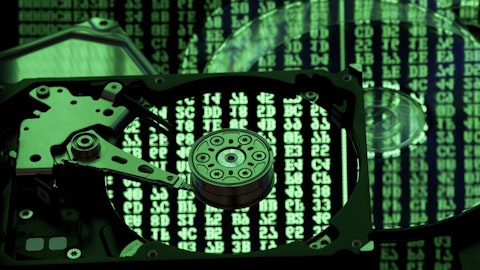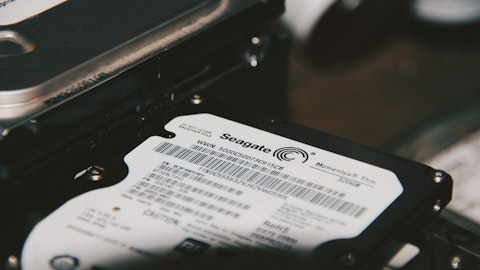Just you can see the pricing stress in the — fairly readily in the dollar per terabyte trends. And so that’s why we have to be very discerning about what deals we’re taking. But I think it’s reflective of a world where manufacturers are just trying to convert inventory back to cash as quickly as they can. And our answer long term has got to be don’t build too much so that we don’t get ourselves into that position and then focus on a transition to a more substantial value proposition like higher capacity or lower cost like VIA, the areal density gains that we might have and we apply that to lower capacity drives, just in order to rebuild the margin for ourselves and for the industry.Operator The next question comes from Wamsi Mohan of Bank of America.Wamsi Mohan I was wondering if you could just maybe talk about the outlook and pricing as well.
It seems like your time line for nearline demand recovery is kind of late in the year, HAMR shipments starting like in volume, maybe early next year. In the interim, clearly, like memory pricing, NAND demand, NAND pricing has been also under significant pressure. So would you say that — as you’re thinking about this comment about gross margin improvement as you go through the course of the year, is that predicated on stable pricing, improving or worsening pricing? Any color you can share? And do you think that, that pricing environment could deteriorate a lot more as you go through the course of the year? And I’ll follow up.Dave Mosley I’ll let Gianluca talk about the restructuring because I think that’s a significant part of your question.
But I would say relative to the pricing environment, this is really where — we believe we have good products that 20 terabytes to mid-20 capacity points and not — there’s not great demand right now, but we have good products that we can yield and so on. The way out of it, of course, is to continue the areal density gains into the mid-30s and we get the chance to reset things a little bit.From my perspective, the demand environment is so low that the way pricing becomes more strained is when we overbuild. And so that’s what we have to make sure that we don’t do because we can’t continue to stress ourselves and our cash that way. So we just have to wait this thing out a little bit. So Gianluca, if you want to talk about the first part.Gianluca Romano Yes.
A good part of the improvement in our gross margin starting fiscal Q1 is related to the restructuring actions that we are taking right now. We said it is about $200 million annualized savings. And it will be fully realized probably through the end of fiscal Q1. The plan is based on the current visibility of pricing. As you know, that can change. And we are trying to reduce our capacity so that we build the right level of products for the current demand, and we take out some pressure from pricing.Wamsi Mohan Okay. Thanks for that color. And if I could follow up, Gianluca, on the comments around positive free cash flow for the remainder of the year. Your free cash flow and EBITDA levels have the potential to deteriorate from current levels. And when we look at that on an LTM basis, it does get you pretty close to your existing covenants.
I know you mentioned certain actions that you can take on sale leaseback and other elements. But howshould investors think about the dividend in this context, given that you have some cash restructuring charges coming up, you do have other uses of cash as well? I know you are paying down debt. But in the context of dividend, should investors think that’s pretty secure as we go through the course of this year? Or is that going to be another lever to use to balance the cash sources and uses for you?Gianluca Romano Seagate has always been very focused on shareholder return. As you know, we have suspended share buyback based on the current economic situation, but we have protected our dividend. We think we can reduce our leverage in the next few quarters or already discussed that leverage level with our banks.
But I’ll say until now, we have always protected our dividend.Dave Mosley Yes. I’d say, Wamsi, that I’m proud of who we’ve been. If you look just over the last 15 years when we came up with some of the policies that we’re talking about, I’m really proud of what have we been able to return value to shareholders. Times are tough right now. We have a lot of levers that we can look at, I think, over time. But we want to continue to be that company that we have been.So we’re factoring this into all of our discussions right now what our priorities are, trying to keep the exact same priorities we’ve always had for shareholders. And one of the reasons why we’re being really aggressive on the cuts that we are, we’re also as aggressively trying to turn some of the assets that we have into cash.
We’ll continue to look at all those options.Operator The next question comes from Timothy Arcuri of UBS.Timothy Arcuri I had two. So Gianluca, just on free cash flow. So are you implying that it’s going to be positive for the June quarter? Because you did extend payables a lot in March, and you’d probably have to bring that down maybe 25 days or so. So it seems like maybe June free cash flow could be quite a bit negative. So what’s the message on June and particularly around cash flow?Gianluca Romano We see June still a positive free cash flow. Of course, we need also to look at the exact timing of the payment for the restructuring actions. But in our plan, we have positive free cash flow for June.Timothy Arcuri You do. Okay. Okay. Then I guess I had a bigger-picture question.
So Dave, in your prepared remarks, you talked about some evaluation of the longer-term capacity needs for the business and that’s kind of a new angle. And we’ve gone from a year ago, thinking that the industry didn’t have enough capacity, and now we’re thinking about having too much on a structural basis.So I guess, can you talk about that and maybe in the context of that, just given how low NAND pricing has gone, we’re now basically at cash cost. Is there a risk that there’s some cannibalization happening now in nearline? And sort of what’s the TCO difference in SSD and nearline now and data center? Is that part of what’s driving you to talk about maybe rethinking what the longer-term capacity needs are for the business?Dave Mosley Okay. Let me address that second problem — or the second question first.
No is the answer to that question. I think we believe that some of the SSD pricing that we’re seeing is unsustainable, fundamentally unsustainable. It might go on for a while, but it’s unsustainable. So we’re not really factoring that into our calculation for exabyte demand over time. I don’t think — even at the rates that we’re seeing today, our ability to continue to take cost out and deliver more terabytes over time is going to keep us with a substantial gap to any competing technology.I will say that your question is super appropriate. It’s — over the last year, industry hasn’t been putting on capacity. There are suppliers that we have that are unfortunately bearing the brunt of this and they’re still assessing their own investments or consolidating the factories and things like that.
So from an equipment perspective, there’s less capacity than there was a year ago.But definitely, from a people perspective, there’s less capacity than there was a year ago because of significant people takedowns, which we know is really hard and nobody wants to do, and that capacity can recover but not quickly. So if you start staring out a year from now, does the industry have the same amount of capacity that it did a year ago? The answer is no.Theoretically, it can grow back, but it’s a matter of time and investment. And from my perspective, the biggest thing we’re focused on is the lead times are so long on some of the starts, for example, wafer starts that we have for the new products that we’re making sure the customers understand that it’s not going to snap back and we better have discussions right now about what the true demand that they they’re going to need fulfilled out there a year from now.In some sense, the kind of consumer behavior where you say, I don’t need to buy any for a while and then I can go — always go to the store and get some.





